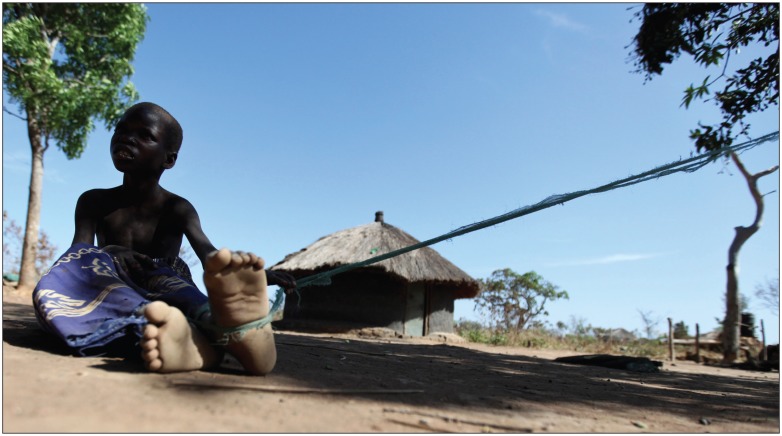Mary Odong sits on the floor of a clinic in northern Uganda as her foot starts to twitch. Her body goes rigid and she drops to the mat, spasming several times and whimpering. She begins to cry and bob her head like a pendulum gone amok.
The 15-year-old girl is suffering from “nodding disease,” or nodding syndrome, as some call it, a disabling and often fatal condition characterized by nodding seizures. It typically afflicts children between the ages of 5 and 15. The seizures often begin when a child eats or feels cold. The ensuing pathology is harsh: mental retardation, a damaged hippocampus, stunted growth.
There is no cure, and treatment is largely confined to symptomatic relief in the form of anticonvulsants. The cause of nodding disease remains a mystery. It was first identified in isolated, mountainous communities in Tanzania in the 1960s.
By the middle part of the 2000s, it was increasingly found in Uganda and South Sudan, particularly along the Yei River, leading many to surmise a link to the parasitic worm Onchocerca volvulus, which causes river blindness (www.cmaj.ca/lookup/doi/10.1503/cmaj.090821).
But the worm is commonly found in areas with no incidence of disease, and the evidence doesn’t appear to firmly support a causal link between the two. Nor does the evidence support another postulate, such as whether the disease is caused by consuming chemically contaminated monkey meat or by a vitamin deficiency.
It’s a riddle, says Dr. Scott Dowdell, director of the United States Centers for Disease Control’s Division of Global Disease Detection and Emergency Response, who was dispatched to Uganda in 2009 with a team of epidemiologists to root out the cause of the disease.
“It’s quite clear now that this is going to take a while to figure out and that we need to be in this for the long haul, because the answers are not so simple or straight forward,” says Dowdell.
The team has ruled out more than 30 different hypotheses, including one that nodding disease — which now afflicts 3000 children in Uganda, according to the country’s ministry of health — was the product of chemical weapons used in the war between the Ugandan government and the rebel Lord’s Resistance Army.
Virus testing in 18 families has revealed nothing, but Dowdell remains hopeful that a link can still be found to a parasite from the Onchocerdicae family. Recent skin snips taken from patients in Uganda and South Sudan have revealed high rates of infection with microfilaria from that family of parasites, he says, adding that infection with microfilaria “is a lot more common in the nodding syndrome patients than the controls. That has been a consistent finding in the studies that we have done.”
Some children suffering from nodding syndrome, including 12-year-old Nancy Lamwaka of Uganda, are tied to trees because their diminished mental capacity makes them prone to wandering and accidents such as drowning.
Image courtesy of REUTERS/Edward Echwalu
Equally speculative is the proposition that nodding disease is caused by a vitamin B6 deficiency, which appears to be common within the local population. It “does make us wonder if high doses of vitamin B6 might be helpful to these children,” says Dowdell.
Such suppositions have led Dowdell and his team, along with Ugandan health officials, to seek approval for a clinical trial involving 80 children that will compare the therapeutic benefits of two anticonvulsants taken in conjunction with large doses of vitamin B6. “With what we have learned so far — that the cause for the nodding is a seizure — we have clues that will allow us to help manage these children,” says Dowell. “Based on the EEGs [electroencephalograms] and what we know [about the disease] we would expect that there should be some response.”
Also in the works is an international conference to hunt for solutions.
Back at the clinic in the Pader district, 15 children sit or lie upon blankets and tarps spread across the floor. There are beds at the back of the room, but they appear to be off limits. “When we put them in beds, they can easily fall out when they have these fits,” explains David Nokrach, a community health worker at the clinic.
The children can suffer several seizures a day. Because they appear to be triggered by food, children are often reluctant, and find it difficult, to eat.
“They have drooling of saliva. They have mental retardation, depending on how many years or the degree of infection,” says Dr. Emmanuel Tenywa, a country advisor in disease control for the World Health Organization in Uganda.
Their appearance can be distressing. “Physically, you will find the children are stunted and malnourished; they have wounds all over their bodies [from accidents],” says Tenywa. Many drown or suffer burns from those accidents. Others, having gone blind or unable to speak, find their fates confusing. It takes a toll not only on the children, but also on their entire families, says Tenywa. “There are families where almost all of the children are affected and some have died.”



